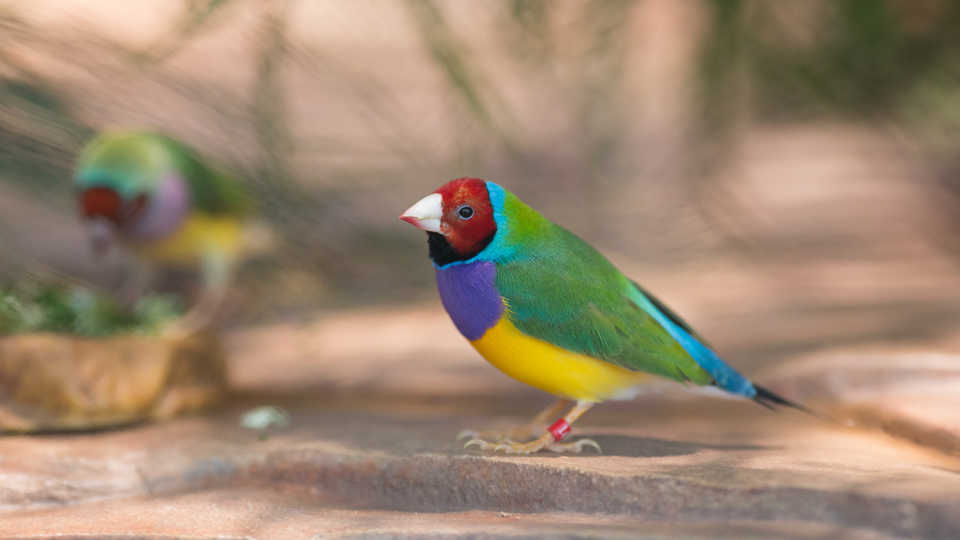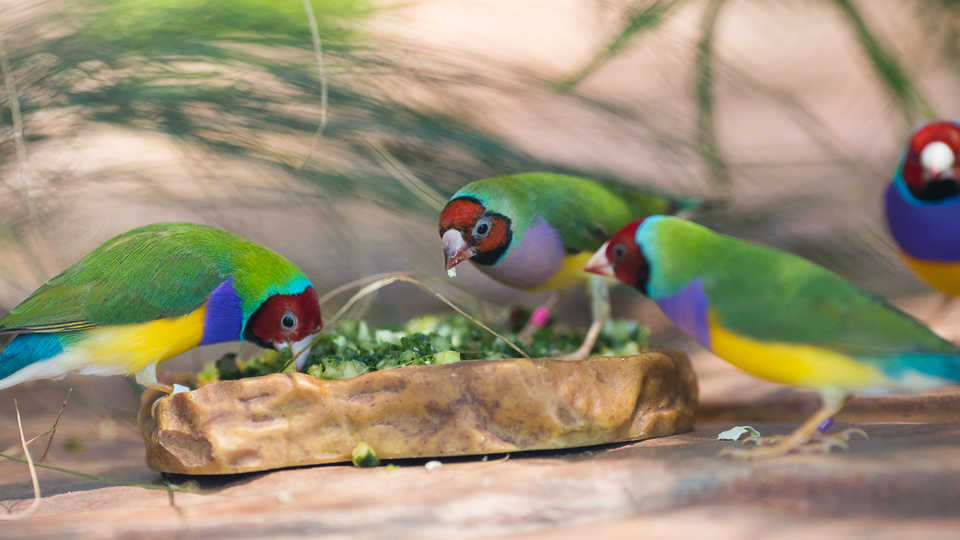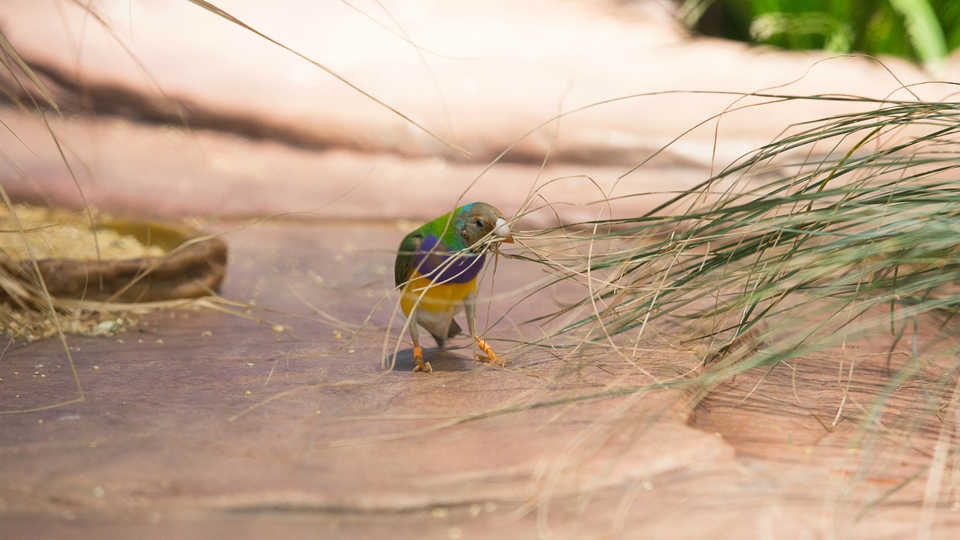Gouldian Finch
For such a small bird, the Gouldian finch (Eryhrura gouldiae) inspires a huge number of questions. This passerine, native to northern Australia, averages just six inches long, but can count itself among the most colorful birds around, with its brilliant and distinctive blocked pattern: green wings, bright purple chest, yellow belly, and turquoise headband. But perhaps the most interesting, and definitely the most telling, characteristic of this species is its head color. In wild populations, there are three possible head color variations, or “morphs”—black, yellow, and red—and how and why each bird sports a particular hue is open to plenty of debate and research.
Polymorphism, which occurs when genetic variation results in two or more “morphs” within a species, is not uncommon in nature. In birds, however, consistent coloration is far more often the norm. In Gouldian finches, scientists have found that color morphs are linked to distinct behavioral characteristics, mate selection, and reproductive success, so the variations are clearly more than coincidence or luck of the genetic draw. Color is simply the observable surface of evolutionary, genetic, and behavioral forces at work.
Gouldian finches were once found in large numbers across northern Australia, spanning the Northern Territory, Western Australia, and Queensland regions, but now the largest population is found in the Kimberley, a sparsely populated area of Western Australia. There are fewer than 3,000 finches remaining in the wild, which puts them on the world’s growing list of endangered species. Recent studies have identified several factors that may have contributed to their place on that list, including cattle grazing, invasive species (both flora and fauna), and increased prevalence of wildfires. In addition, thousands of wild Gouldian finches were captured during the early 20th century and sold to aviculture enthusiasts worldwide. The birds are still widely traded in that community, but captive populations now differ from the wild ones, having been bred for several non-natural color mutations.
Color Sources
A lot of genetic coordination and several different cellular processes go into the Gouldian finch’s extravagant coloration. To start, their six colors come from a number of different sources. For example, finches acquire their red and yellow colors from their diet, which consists of grass seeds, particularly sorghum. These foods contain red-hued carotenoid pigments that are absorbed by the bird’s fatty tissues and expressed in its feathers. The blues we see are structural colors, which are expressed when light is reflected through nanostructures within the feather. Greens and purples are a combination of blue structural colors and carotenoid pigments. Finally, black is the result of melanin pigment, produced by the skin cells as the feathers grow. Whether or not melanin is produced is determined by a recessive sex-linked gene. When present, melanin completely masks the carotenoid pigments.
What Your Color Says About You
Coloration provides a tremendous amount of information within a Gouldian finch population and plays an important role in mate selection and reproductive success.
Male and female Gouldian finches share the same distribution of colors but males are, as is common in the animal kingdom, brighter than females. The brightness of a bird’s coloration can provide a powerful visual indication of its fitness, and in particular, its ability to obtain food. Birds that have the richest diets tend to have more vibrant plumage and will therefore be more attractive to potential mates.
Interestingly, head color is the most important indicator of all and is linked closely to behavior: Red-headed finches are the most competitive and aggressive of all the morphs, usually winning access to the best nesting sites—hollows in eucalyptus trees—and food sources. The trade-off for this advantageous characteristic is a shorter life-span and decreased parental investment; red-headed males are less helpful in raising young because they spend more time fighting.
Gouldian finches also follow an assortative mating pattern, meaning that they prefer to mate with finches that look like them. This isn’t just aesthetic preference. Studies show that females in incompatible pairings tend to produce higher levels of stress hormones. As a result, they have smaller broods with fewer females, the sex most adversely affected by a poor match (in line with a genetic observation known as Haldane’s rule). Although mating with like individuals tends to improve breeding success, it also negatively affects genetic diversity within a population by limiting gene flow. This in turn may lead to reproductive isolation and a loss of rare morphs.
Speciation in Progress?
In most organisms, breeding between different morphs doesn’t have the same sort of negative impact on reproductive success as breeding between species. The fact that breeding between two morphs has such a powerful effect suggests that E. gouldiae population segments are in the process of diverging.
There are a couple hypotheses as to what scientists are currently observing in Gouldian finch behavior. First, it’s possible that the three different morphs are a result of vicariant evolution, a speciation tale as old as time that involves the separation—usually by environmental factors—of a population and its subsequent evolutionary branches. The morphs would have evolved into different subspecies in isolation, but rejoined into one breeding population after another geographic shift. This type of transitional phase usually has one of several results: the two species will interbreed freely without incompatibility and merge back into a single species; one of the two species will go extinct due to incompatibility; or they will develop pre-mating isolation behavior (such as assortative mating) and evolve into separate species. For Gouldian finches, the latter two possibilities seem the most likely.
A second hypothesis points toward sympatric speciation, in which a new species evolves from an ancestral species through a genetic mutation. Interestingly, the ratio of Gouldian finch morphs across Australia has stayed relatively constant across time and geography to the present day, with black morphs comprising 70% of the total population, red at 30%, and yellow morphs making up less than one percent. If the morphs were separated geographically at one point, one would expect a higher percentage of one morph or another to be found in certain geographic regions. Gouldian finches are long-distance travelers, however, making this even distribution plausible.
Although scientists don’t know exactly what caused such incompatibility within Gouldian finch populations, it’s very likely that the existence of all three morphs is a mere blip in this species’ long evolutionary history. What we’re witnessing now is likely just a particularly fascinating stage of speciation in progress.
Share This
Visit our Gouldian finch aviary in the Color of Life exhibit.



